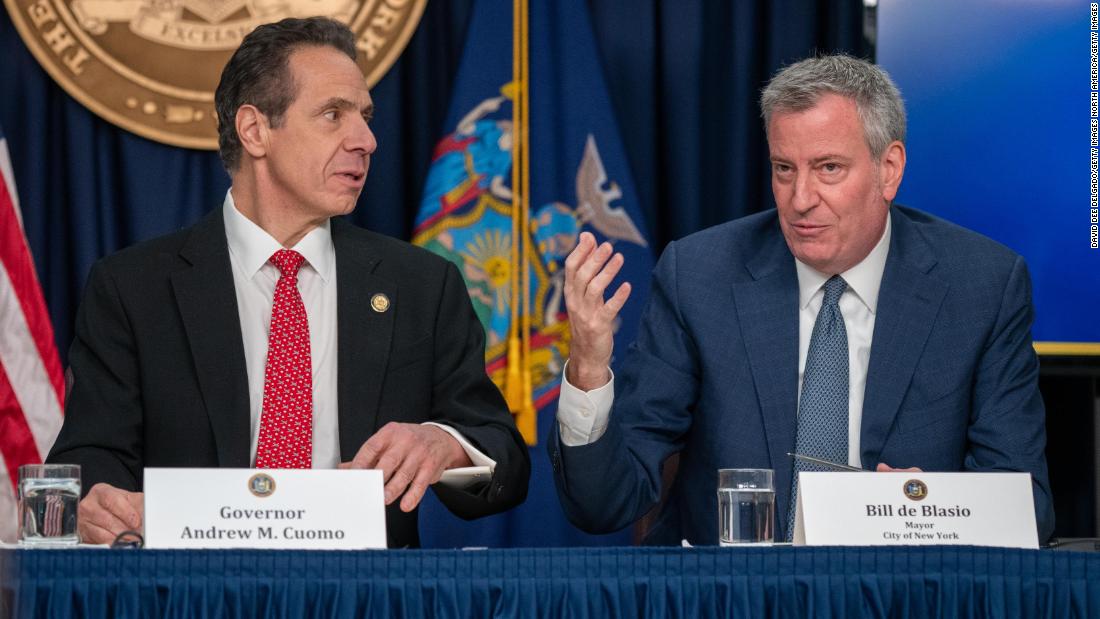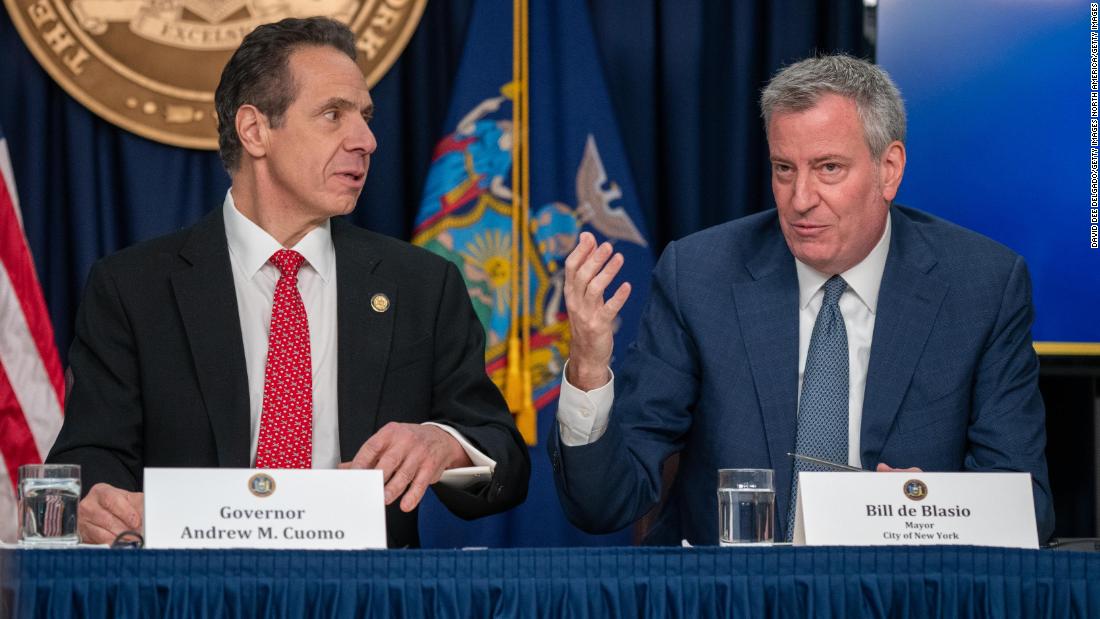[ad_1]

On Tuesday, the Democratic governor said during a press conference that the instances of looting and property destruction that cam as peaceful protests took place one night earlier showed that “the NYPD and the mayor did not do their job last night.”
Then, he took it a step further.
“My option is to displace the mayor of New York City and bring in the National Guard — as the governor, in a state of emergency — and basically take over the mayor’s job,” Cuomo said. He quickly added that, “I don’t think we are at that point,” and that doing so would aggravate an already precarious situation.
For longtime observers of the governor and New York City Mayor Bill de Blasio, a fellow Democrat, Cuomo’s suggestion that he could usurp the mayoralty of his one-time friend and colleague was a stunning escalation of their years-long feud, one that had cooled in recent months, but was rooted in years of tension and dozens of episodes of conflict and bickering.
It began just a few months after de Blasio took office in 2014 amid the newly installed mayor’s push to expand pre-kindergarten and after-school programs in New York City. Their rocky start was quickly evident despite an initial joint press conference that January touting their cozy relationship.
“We use the word ‘friend’ in politics often and sometimes casually,” Cuomo said at the time. “But the new mayor of New York truly is a friend in the deepest sense of the word.”
They’ve quarreled over homelessness, public housing, funding mass transit, taxes and the deployment of state troopers to New York City.
After the deer found itself in a public housing complex, police captured him and the city announced plans to kill the animal, saying it was the recommendation of experts. But Cuomo quickly stepped in, saying the state would move the deer, and what followed was hours of competing statements by the two elected officials until the deer finally died in captivity.
During the coronavirus pandemic, Cuomo and de Blasio have largely sidestepped each other, with some exceptions. In March, a day after de Blasio told city residents to prepare for a “shelter in place” order, the governor said he wouldn’t approve such a step, and while Cuomo ultimately instructed New Yorkers to stay home as much as possible, he refused to define the policy as “shelter in place.”
In mid-April, de Blasio announced plans to keep the New York City public school system closed through the end of the academic year. But hours later, Cuomo said the decision wasn’t the mayor’s to make, and it wasn’t until May 1 that the governor said schools throughout the state would remain shuttered.
Despite those disputes, both Cuomo and de Blasio have said they’ve found common ground during the pandemic and more recently amid the protests sparked by the death of George Floyd.
“I think the fact is that when there are so many areas where we’ve agreed during this crisis and our teams have worked together and we’ve made things happen, and then a few areas of disagreement, that’s pretty normal. That’s pretty human,” de Blasio told radio station 1010 WINS. “So, I know people don’t like it and I don’t blame them, but in the end, we’re getting a lot done.”
Regarding the criteria for reopening New York City, Cuomo said: “We’re on totally the same page, because there’s only one page: There’s state guidelines, period.” He added: “The mayor has his schedule. I have my schedule. I talk to him all the time. But there’s only one page.”
During a Cuomo press conference to announce that New York City could move into Phase 1 reopening, the mayor joined the governor, videoconferencing into the event.
Longtime observers agreed. “I can’t think of a single decision that either of them has made that would be different if they were best buds,” Eric Phillips, a former de Blasio press secretary who worked for the mayor during years when de Blasio and governor were at each other’s throats, said of their behavior during the pandemic.
Regarding school closures, for example, Phillips attributed any dispute to their distinct constituencies. “The mayor wanted his schools to have notice faster than the governor could get the state synched up,” he said. “I think they were just playing two different natural roles.”
For the most part, say political insiders who have observed their relationship for years, that is because de Blasio has largely stepped out of the governor’s way now that the mayor, whose term is up at the end of next year, is looking at his final stretch in City Hall.
“I think the feud has been, to be honest, it’s far more muted and of almost negligible impact simply because when the feud was at its height, the feeling was de Blasio was leading this progressive surge to take on the governor, but what’s happened is that de Blasio has turned lame duck,” said Bruce Gyory, a Democratic political consultant who has closely followed their relationship, speaking before Cuomo’s musing about the option to “displace” the mayor.
When de Blasio took office, he positioned himself as liberal leader fighting mainly against centrist Democrats like Cuomo. De Blasio notched a number of significant progressive wins, but in the last two years he has suffered two significant political defeats: first, his longtime ally Cynthia Nixon tried and failed to unseat Cuomo in the Democratic primary during the 2018 gubernatorial election; and second, de Blasio himself performed miserably in his short-lived 2020 presidential bid.
“I think the governor has just moved past (the feud) simply because the mayor, in terms of his public prestige and his influence to move the City Council, he’s just of no threat,” Gyory said. “They’ve had their disagreements, but they’ve been very mild. There’s been a mutual disengagement. Even when the governor disagrees with (de Blasio), he never personalizes it. He’ll either refer to him as the mayor without saying ‘Bill de Blasio,’ or he’ll talk about the office.”
That was until Tuesday, when Cuomo floated the notion of taking over de Blasio’s job. In the 24 hours since, however, after coming under fire from the mayor, the police department and police unions, Cuomo offered that he wasn’t criticizing “the men and women of the NYPD” but rather questioning “the management and deployment of the NYPD” and, according to the NYPD Chief of Department Terence Monahan, Cuomo apologized privately to NYPD Commissioner Dermot Shea.
Monahan said in an interview that Cuomo should apologize to the police force publicly as well, and while the governor didn’t do so, he was complimentary in his assessment of the NYPD on Wednesday, praising an increase of police on the streets and saying “they have to get the support they need.”
“I believe it’s the best police department in the country,” he said. “We got results. Last night was a much, much better night than the night before.” He made no mention of the mayor.
[ad_2]
Source link

